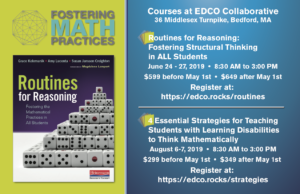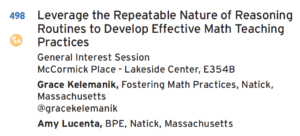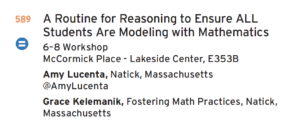Goal: Think like a mathematician! Looking for repetition in the way you draw or count, then generalize the regularity.

Source: Pattern #75 on www.VisualPatterns.org
Back to Recognizing Repetition TasksGoal: Think like a mathematician! Looking for repetition in the way you draw or count, then generalize the regularity.

Source: Pattern #75 on www.VisualPatterns.org
Back to Recognizing Repetition Tasks

Register at: https://edco.rocks/routines
Learn more about the seminar and pre-session - Leverage the Repeatable Nature of Reasoning Routines to Develop Equitable Math Teaching Practices - on the Teachers Development Group website https://www.teachersdg.org/leadership-seminar/
Essential Strategies for Teaching Students with Learning Disabilities to Think Mathematically
Amy and Grace are Speaking Friday at 2:30 and Saturday at 8:00


Click here for more about NCTM's 100 Celebration
New Year, New Ideas: Curriculum Associates National Mathematics Summit. More info
Participants will develop a deep understanding of what it means to think and reason mathematically. They will learn three distinct ways of thinking mathematically championed in the Common Core State Standards for Mathematical Practice: reasoning quantitatively, thinking structurally, and reasoning through repetition. In addition, participants will learn how to develop these avenues of thinking in their students.
Register here by June 7th at noon EDT
Are you thinking about how to address students’ unfinished learning? We are too! In this webinar, we will share our current thinking on how to leverage reasoning routines to assess and advance underdeveloped math concepts from the previous year. We will discuss how students’ capacities to reason quantitatively and think structurally hold the keys to building new mathematical understandings and connections. We will focus on critical concepts in middle school mathematics: ratio and proportional relationships, algebratizing arithmetic, rational number concepts, geometric relationships, and/or functions. Join us to explore this building-on-strengths approach to accelerating unfinished learning.
Register by August 2nd at noon, EDT
Synchronous sessions will take place between 11:00 AM and 3:00 PM EDT
Register here by August 16th at noon EDT
Participants will develop a deep understanding of how five research-based strategies (ask yourself questions, sentence frames and starters, annotation, the Four R’s, and turn-and-talks) can be used to help students with learning disabilities develop mathematical thinking. They will learn about six accessibility areas (conceptual processing, visual-spatial processing, language, attention, organization, and memory) math learners must use when doing mathematics. They will see how the essential strategies support students as they work in each of the accessibility areas by engaging in an instructional routine designed to develop mathematical thinking. Participants coalesce their learnings as they apply the course ideas to draft IEP goals that focus on students’ mathematical thinking.
Asynchronous from
Oct 6 - Nov 30, 2021
2 recorded synchronous sessions, Oct 27th and Nov 9th 7-8 pm Eastern
Reasoning Routines: A window into the process to design your own
For more information
Sessions
Saturday 10:30-12:00 Designing A Reasoning Routine to Develop Mathematical Thinking
Saturday 1:15-2:45. Build Student Agency through Mathematical Modeling
Sessions
Do your students struggle to make sense of word problems on their own? In this 90-minute webinar, you’ll learn why students struggle to interpret math word problems. We’ll talk about how word problems are written and why their design often creates a stumbling block for students. You’ll learn about the Three Reads reasoning routine and how it can help your students develop into powerful math readers. Participants will leave the webinar with concrete strategies they can implement immediately to help their students read with a mathematician’s eye.
More information
Are you looking for effective and efficient ways to address students’ unfinished learning? In this 90-minute webinar, we will share our current thinking on how to leverage reasoning routines to assess and advance underdeveloped math concepts from the previous year. We will discuss how students’ capacities to reason quantitatively and think structurally hold the keys to building new mathematical understandings and connections. We will focus on critical concepts in middle school mathematics: ratio and proportional relationships, algebratizing arithmetic, rational number concepts, geometric relationships, and/or functions. Join us to explore this building-on-strengths approach to accelerating unfinished learning.
More information
Register here:
https://tec-coop.org/event/what-is-mathematical-thinking-and-how-do-we-teach-it/
Keynote with follow up sessions: What is Mathematical Thinking and How Do We Foster it in All Students?
For more information:
https://www.escweb.net/tx_esc_04/catalog/multivenue.aspx?isSearch=0&event_id=1645569
For more information:
https://delawaremathcoalition.org/event/triple-crown-conference-2022/
For more information:
https://www.nctm.org/indy2022/
For more information and to register click here
For more information or to register click here.
Join us online for our math thinking course! Registration deadline is 12PM Eastern on January 23, 2023. More information and registration.
Our Session: Leveraging the Math Practices to Grow Confident, Creative, and Joyful Math Doers and Learners
For more info click here.
Title: Essential Strategies for Teaching Students with Learning Disabilities to Think Mathematically. Click here for more info.
For more information and FREE registration, click here
Click here for information and to register.
Click here for more info and to register.
Essential Strategies for Teaching Students with Learning Disabilities to Think Mathematically. Click here for more info and to register.
Curriculum Associates Strategies for Success Webinar Series. Click here for more info and to register.
Curriculum Associates Strategies for Success Webinar Series. Click here for more info and to register.
Do you find that your students often need your help to get started on math problems, or that they shut down when they don’t know how to begin? This webinar can help. Click here for more information and to register
Do your students struggle to remember math procedures or see math as a disconnected collection of topics to be mastered? This upcoming webinar can help. Click here for more info and to register.
Are you looking for ways to help all of your students stay engaged and involved during full group conversations in math class? If so, this upcoming webinar can help. Click here form more info and to register.
It can be frustrating when you ask a question in class and receive no response or when you try to facilitate a discussion, and no one participates. If you’ve experienced this, you may be interested in the upcoming webinar on Mathematical Discourse for all. Click here for more info and to register.
Click here for more info and to register.
Our sessions include, Strategies to Shine a Light on Student Thinking and Voice; and Reasoning Routines that Develop Individual and Collective Brilliance and Agency through Discourse. Click here to see our presentations.
In this course, participants will dive deeply into engagement routines to support students throughout three major components of mathematics learning experiences: sense-making, sharing and developing concepts and ideas, and solidifying understandings. Click here for more info and to register.
Authors Grace Kelemanik and Amy Lucenta are hosting this opportunity to unpack ideas, learn, practice, and understand how a relatively small number of instructional routines can support high-quality classroom teaching and learning. Grace and Amy will share why they wrote the book, answer questions, and bring experience from their work in classrooms around the country. Click here for more info and to register.
Authors Grace Kelemanik and Amy Lucenta are hosting this opportunity to unpack ideas, learn, practice, and understand how a relatively small number of instructional routines can support high-quality classroom teaching and learning. Grace and Amy will share why they wrote the book, answer questions, and bring experience from their work in classrooms around the country. Click here for more info and to register.
Authors Grace Kelemanik and Amy Lucenta are hosting this opportunity to unpack ideas, learn, practice, and understand how a relatively small number of instructional routines can support high-quality classroom teaching and learning. Grace and Amy will share why they wrote the book, answer questions, and bring experience from their work in classrooms around the country. Click here for more info and to register.
Authors Grace Kelemanik and Amy Lucenta are hosting this opportunity to unpack ideas, learn, practice, and understand how a relatively small number of instructional routines can support high-quality classroom teaching and learning. Grace and Amy will share why they wrote the book, answer questions, and bring experience from their work in classrooms around the country. Click here for more info and to register.
Re-envisioning IEPs (FREE) Webinar January 22nd at 7 pm Eastern. Register here
Essential Strategies to Teach Students with Learning Disabilities to Think Mathematically
Learn more and register
Click here for course info and to register
Comments are closed.
We used this task with a group of 8th graders. They loved it! They thought of at least 8-10 different ways to conceptualize the growth in this sequence, based on the visual pattern rather than just making a table of values. It was really impressive and they were thoroughly engaged. The task has a very low floor and a high ceiling, so it differentiates itself. It also was a rich source for mathematical discourse. Thanks!
Sounds like paying attention to process paid off for your students!
Working on this task with 8th graders, we saw several students come to the board to share their generalizations who rarely participate in class. One of these students came to the board and was the first to point out that the number of rows of 2 dots on each side was one less than the figure number. This led to the class generalizing, and coming up with an expression, from her “chunking”.
Also, this task led to students having lengthy, rich discussions when sharing their repetitions and generalizations.
It is exciting to hear that the routine offered entry points to students who typically do not participate in math class. Do you have a sense of what exactly it is about Recognizing Repetition that hooked those students?